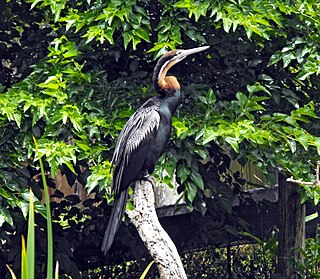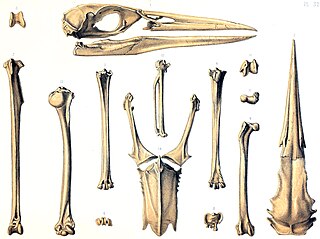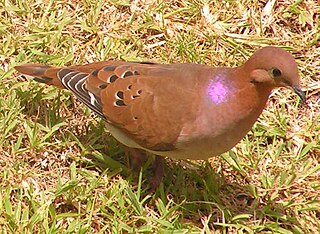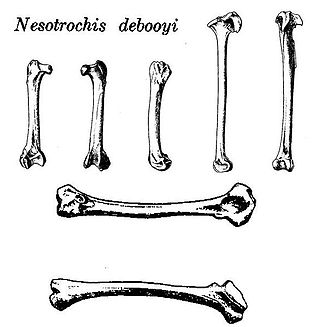
The darters, anhingas, or snakebirds are mainly tropical waterbirds in the family Anhingidae, which contains a single genus, Anhinga. There are four living species, three of which are very common and widespread while the fourth is rarer and classified as near-threatened by the IUCN. The term snakebird is usually used without any additions to signify whichever of the completely allopatric species occurs in any one region. It refers to their long thin neck, which has a snake-like appearance when they swim with their bodies submerged, or when mated pairs twist it during their bonding displays. "Darter" is used with a geographical term when referring to particular species. It alludes to their manner of procuring food, as they impale fishes with their thin, pointed beak. The American darter is more commonly known as the anhinga. It is sometimes called "water turkey" in the southern United States; though the anhinga is quite unrelated to the wild turkey, they are both large, blackish birds with long tails that are sometimes hunted for food.

The Gruiformes are an order containing a considerable number of living and extinct bird families, with a widespread geographical diversity. Gruiform means "crane-like".

Rails are a large, cosmopolitan family of small- to medium-sized terrestrial and/or semi-amphibious birds. The family exhibits considerable diversity in its forms, and includes such ubiquitous species as the crakes, coots, and gallinule; other rail species are extremely rare or endangered. Many are associated with wetland habitats, some being semi-aquatic like waterfowl, but many more are wading birds or shorebirds. The ideal rail habitats are marsh areas, including rice paddies, and flooded fields or open forest. They are especially fond of dense vegetation for nesting. The rail family is found in every terrestrial habitat with the exception of dry desert, polar or freezing regions, and alpine areas. Members of Rallidae occur on every continent except Antarctica. Numerous unique island species are known.

Coots are medium-sized water birds that are members of the rail family, Rallidae. They constitute the genus Fulica, the name being the Latin term for "coot". Coots have predominantly black plumage, and—unlike many rails—they are usually easy to see, often swimming in open water.

The St. Croix macaw or Puerto Rican macaw is an extinct species of macaw whose remains have been found on the Caribbean islands of St. Croix and Puerto Rico. It was described in 1937 based on a tibiotarsus leg bone unearthed from a kitchen midden at a pre-Columbian site on St. Croix. A second specimen consisting of various bones from a similar site on Puerto Rico was described in 2008, while a coracoid from Montserrat may belong to this or another extinct species of macaw. The St. Croix macaw is one of 13 extinct macaw species that have been proposed to have lived on the Caribbean islands. Macaws were frequently transported long distances by humans in prehistoric and historical times, so it is impossible to know whether species known only from bones or accounts were native or imported.

The Rodrigues night heron is an extinct species of heron that was endemic to the Mascarene island of Rodrigues in the Indian Ocean. The species was first mentioned as "bitterns" in two accounts from 1691–1693 and 1725–1726, and these were correlated with subfossil remains found and described in the latter part of the 19th century. The bones showed that the bird was a heron, first named Ardea megacephala in 1873, but moved to the night heron genus Nycticorax in 1879 after more remains were described. The specific name megacephala is Greek for "great-headed". Two related extinct species from the other Mascarene islands have also been identified from accounts and remains: the Mauritius night heron and the Réunion night heron.

The Rodrigues rail, also known as Leguat's gelinote or Leguat's rail, is an extinct species of the rail family that was endemic to the Mascarene island of Rodrigues. The bird was first documented from life by two accounts from 1691–93 and 1725–26. Subfossil remains were later discovered and correlated with the old accounts in 1874, and the species was named E. leguati in Leguat's honour. It is generally kept in its own genus, Erythromachus, but has sometimes been assigned to the genus Aphanapteryx along with its close relative the red rail of Mauritius; their relationship with other rails is unclear.

The fauna of Barbados comprises all the animal species inhabiting the island of Barbados and its surrounding waters. Barbados has less biodiversity than the other Antilles. Human activities are responsible for the change in the composition of the fauna, in particular, the replacement of native species. Species that are able to adapt to human presence have survived.

The Saint Helena dove is an extinct species of flightless bird in the family Columbidae. It is monotypic within the genus Dysmoropelia. It was endemic to the island of Saint Helena in the South Atlantic Ocean. It is known from remains of Late Pleistocene age found at the Sugarloaf Hill locality, which consists of aeolian calcareous sands. The holotype consists of a right coracoid, with paratypes consisting of "distal end of right tarsometatarsus, (S/1963.25.29) distal half of right humerus, (S/1963.25.26) worn left tibiotarsus lacking distal end, distal portion of shaft of left tarsometatarsus, (S/1963.25.30) worn proximal end of right humerus. left ulna, proximal fragments of left ulnae, (175959) proximal end of right femur, (175962) distal end of right humerus"

Pardirallus is a genus of bird in the family Rallidae. It contains three species native to marshland areas of Southern, Central America and the Caribbean, although fossil evidence indicates they once ranged north to what is now Idaho. They are 25–38 cm long and have a long greenish bill and reddish legs. The spotted rail is blackish-brown with white markings while the other two are brown above and dark grey below.

The great Oʻahu rail or great Oʻahu crake is a little-known extinct bird species from Oʻahu, Hawaiʻi, attested only by a few subfossil bones. The holotype is a right tarsometatarsus found in a flooded sinkhole on the ʻEwa Plain near Barbers Point, the southwestern tip of Oʻahu.

The great Maui crake or great Maui rail is an extinct bird species from Maui, Hawaiian Islands, known only from subfossil bones. The holotype are the bones of one almost-complete skeleton, found in Auwahi Cave on the lower southern slope of Haleakalā at 1,145 m AMSL. Its first remains, however, were recovered in 1972 and/or 1974 from lower Waihoi Valley further east and less than half as far uphill.

The Antillean cave rail, also known as DeBooy's rail, is an extinct species of flightless bird which occurred on Puerto Rico and the United States Virgin Islands.
The pile-builder megapode is an extinct species of megapode. The subfossil remains were found by Jean-Christophe Balouet and Storrs L. Olson in the Pindai Caves of New Caledonia. Its remains have also been found on Tonga.
Paleontology or palaeontology is the study of prehistoric life forms on Earth through the examination of plant and animal fossils. This includes the study of body fossils, tracks (ichnites), burrows, cast-off parts, fossilised feces (coprolites), palynomorphs and chemical residues. Because humans have encountered fossils for millennia, paleontology has a long history both before and after becoming formalized as a science. This article records significant discoveries and events related to paleontology that occurred or were published in the year 1965.
Cyphornis is a genus of the prehistoric pseudotooth birds. These were probably rather close relatives of either pelicans and storks, or of waterfowl, and are here placed in the order Odontopterygiformes to account for this uncertainty.

Dasornis is a genus of prehistoric pseudotooth birds. These were probably close relatives of either pelicans and storks or waterfowl; they are placed in the order Odontopterygiformes to account for this uncertainty.
Palaeochenoides is a genus of the prehistoric pseudotooth birds of somewhat doubtful validity. These were probably rather close relatives of either pelicans and storks, or of waterfowl, and are here placed in the order Odontopterygiformes to account for this uncertainty.

The Jamaican ibis, Jamaican flightless ibis or clubbed-wing ibis is an extinct bird species of the ibis subfamily uniquely characterized by its club-like wings. It is the only species in the genus Xenicibis, and one of only two flightless ibis genera, the other being the genus Apteribis which was endemic to Hawaii's islands of Maui Nui.














